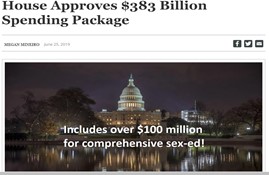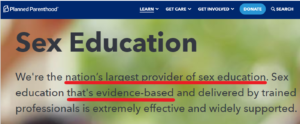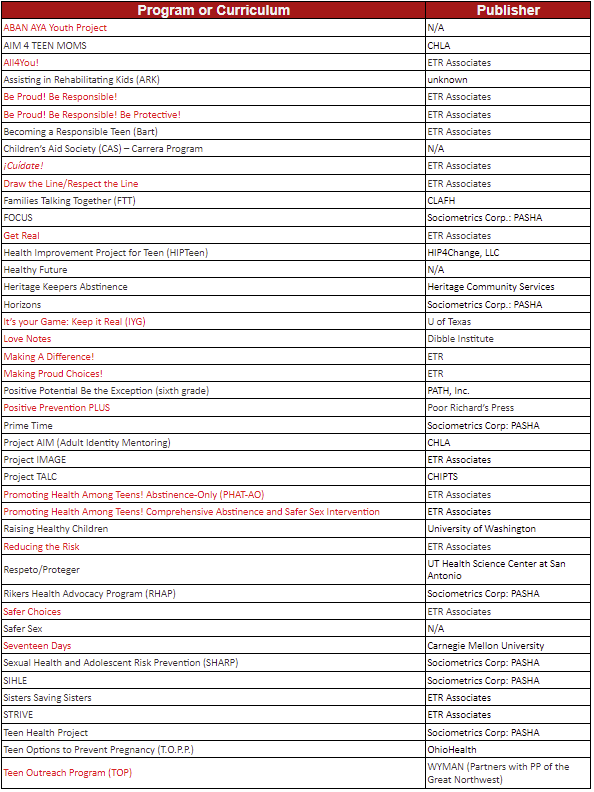In June 2019, the House approved $383 billion spending which includes over $100 million for comprehensive sex ed.

This federal funding goes to Adolescent Pregnancy Prevention (APP) programs and the Teen Pregnancy Prevention Program (TPP). Potential TPP grantees can only get a grant from TPP money if they pick from the approved list of programs. Most TPP-approved programs are created, researched and sold by Planned Parenthood and its components. Much of the approved curricula are filled with harmful elements that sexualize ALL children and promote high-risk sexual behaviors. Furthermore, many lessons refer youth to Planned Parenthood facilities for their sexual needs.
In addition, some APP programs, such as PREP, require that curricula/programs are to be “evidence based” or “medically accurate.” Yet research shows that often funds go to curricula/programs that are ineffective. (See SexEdReport.org.) Moreover, other APP programs, such as Title V SRAE, require that curricula/programs “implement education exclusively on sexual risk avoidance” in order to receive funding. Yet content analyses show that many programs normalize teen sex, encourage sexual pleasure-seeking, condone early sexual debut and promote high-risk sexual behaviors.
In Summary: Planned Parenthood is the “single largest provider of sex education in the United States, reaching 1.5 million people with education and outreach each year.” They create programs paid for by federal money, and they research and publish their own programs paid for by federal money. These programs sexualize children and promote high-risk sexual behaviors and then refer them to Planned Parenthood facilities for their sexual needs.

Warning: The Sexuality Information and Education Council of the United States (SIECUS), an organization founded in 1964 by Dr. Mary Calderone, a Kinsey enthusiast who had been the medical director for Planned Parenthood, recently introduced their 2021 State of Sex Education Legislative Overview including mandating federal legislation for national comprehensive sex education through passage of the Real Education for Healthy Youth Act (REHYA) and the Youth Access for Sexual Health Services (YASHS) “implement[ing] safeguards to strengthen federal sex education streams such as the Teen Pregnancy Prevention Program (TPPP) and eliminate[ing] funding for detrimental abstinence-only-until-marriage ‘Sexual Risk Avoidance Education’ programs.” SIECUS’ goal is to use sex ed as a vehicle for social change.

See dangerous Comprehesive Sexualtiy Education programs in your state.
U.S Federal Funding Types
TPP–Teen Pregnancy Prevention
The Teen Pregnancy Prevention Program, administered by the Office of Adolescent Health (OAH), which merged with the Office of Population Affairs (OPA) in June 2019, is defined as an “evidence-based” grant program which funds comprehensive sex education programs for children aged 10 to 19. Established by a Congressional mandate to fund “medically accurate and age-appropriate” programs during the Obama administration, these grants are associated with the Affordable Care Act.
Warning: Research shows that most TPP programs are ineffective at reducing pregnancy rates, and some even increase risk. (See SexEdReport.org) In addition, though terms such as “medically accurate” and “age appropriate” were once effective modifiers that served to protect children from exposure to harmful and explicit sexuality education, it is the sexual rights activists who are implementing sexuality education programs for children who will determine the definition of these terms and not the policymakers who believe that the use of the terms will protect kids. The terms “medically accurate” and “age appropriate” can no longer be considered protective language because of different notions of what is actually defined as safe for children.
See TPP-funded programs in your state
APP–Adolescent Pregnancy Prevention Programs
Adolescent Pregnancy Prevention Programs, administered through the Family and Youth Services Bureau, include seven funding streams and were created to prevent adolescent pregnancy, the spread of sexually transmitted diseases and other risky behaviors among adolescents. FYSB claims a holistic approach to support state, Tribal and community efforts to help youth reduce and avoid risks associated with teen sex and other risky behaviors.
Warning: While grants indicate efforts to “reduce and avoid risks associated with teen sex,” content analyses show that many programs funded by APP grants normalize teen sex, encourage sexual pleasure-seeking, condone early sexual debut and promote high-risk sexual behaviors.
Some of the funding streams include:
- State Personal and Responsibility Education Program (PREP) – are funds to “promote proven methods for reducing adolescent pregnancy, delaying sex among young people, and increasing the use of condoms and other contraceptives among sexually active youth” through placing substantial emphasis on both abstinence and contraception education. PREP runs a cycle of four years. In FY 2020, over $43.6 million was awarded to 51 State PREP grantees.
Warning: While grant requirements may state that in order to receive funding, curricula/programs “must place substantial emphasis on both abstinence and contraception education for the prevention of pregnancy and STIs,” content analyses show that many PREP- funded programs normalize teen sex, encourage sexual pleasure-seeking, condone early sexual debut and promote high-risk sexual behaviors. It is important to look at the actual content of every curriculum rather than rely on labels assigned to them. For example, the analysis of Making a Difference shows CSE programs sexualize children and encourage promiscuity and risky sexual behavior.
See Current PREP grantees
See PREP grantee profiles
See PREP factsheet (click here if link does not work)
See PREP-funded programs in your state
- Competitive Personal and Responsibility Education Fund (CPREP) – If a state does not apply for State PREP allocations, the funding is made available for 36-month discretionary Competitive PREP grants in subsequent years. Eligible entities in those jurisdictions include faith-based and community-based organizations including Planned Parenthood.
See Warning above
See Current CPREP grantees
See CPREP grantee profiles
See CPREP factsheet
See CPREP-funded programs in your state
- Sexual Risk Avoidance Education General Departmental-Funded (GD SRAE) – The purpose is to fund projects that exclusively implement sexual risk avoidance education that teaches youth how to voluntarily refrain from non-marital sexual activity. (SRAE replaced the “Competitive Abstinence Education” (CAE) grant program.)
Warning: While grant requirements may state that curricula/programs are to exclusively implement sexual risk avoidance education that teaches youth how to voluntarily refrain from non-marital sexual activity, content analyses show that many SRAE-funded programs normalize teen sex, encourage sexual pleasure-seeking, condone early sexual debut and promote high-risk sexual behaviors. It is important to look at the actual content of every curriculum rather than rely on labels assigned to them.
For example, the analysis of Making a Difference, Making Proud Choices and Promoting Health Among Teens shows CSE programs sexualize children, encourage promiscuity and risky sexual behavior, and redefine “abstinence” as “most sexual activities that keep the sperm from the egg.”
See Current GD-SRAE grantees
See other SRAE grantee profiles
See GD-SRAE factsheet
See GD-SRAE-funded programs in your state
- Title V State Sexual Risk Avoidance Education (Title V SRAE) – The purpose of Title V SRAE funds is to implement education exclusively on sexual risk avoidance and teach personal responsibility, self-regulation, goal setting and the prevention of other youth risk behaviors without normalizing teen sexual activity. It is a requirement for States to use an evidence-based approach and/or effective strategies to educate youth on the optimal health behavior of avoiding non-marital sexual activity and other risky behaviors.
Warning: While grant requirements may state that curricula/programs are to implement education exclusively on sexual risk avoidance without normalizing teen sexual activity, content analyses show that many Title V-funded programs normalize teen sex, encourage sexual pleasure-seeking, condone early sexual debut and promote high-risk sexual behaviors. Furthermore, research shows that many funded programs are ineffective at reducing pregnancy rates, and some even increase risk. (See SexEdReport.org)
It is important to look at the actual content of every curriculum rather than rely on labels assigned to them. For example, the analysis shows that programs like Making a Difference, Making Proud Choices and Promoting Health Among Teens (Abstinence-only) sexualize children and encourage promiscuity and risky sexual behavior.
See Current Title V SRAE grantees
See Title V SRAE grantee profiles (HHS.gov has not provided the information at this time.)
See Title V SRAE factsheet
See Title V SRAE programs in your state
- Title V Competitive Sexual Risk Avoidance Education (Title V-C SRAE) – Organizations and entities in states and territories that had not applied for Title V State Sexual Risk Avoidance education grants became eligible to submit competitive applications for Title V Competitive SRAE funding. Requirements and purpose are the same as Title V SRAE above.
See Warning above
See Current Title V-C SRAE
See Title V-C SRAE grantee profiles
(HHS.gov has not provided the information at this time. A FOIA request may be needed to access information you are searching.)
See Title V-C SRAE factsheet
See Title V-C SRAE programs in your state
DASH–Division of Adolescent and School Health
The CDC, through its Division of Adolescent and School Health (DASH), promotes environments where youth can gain fundamental health knowledge and skills, establish healthy behaviors, and connect to health services to prevent HIV, STDs and unintended pregnancy. DASH works to protect and improve the health of youth by:
- collecting and analyzing data that drive action.
- translating science into innovative programs and tools that protect youth.
- supporting a network of leaders in primary prevention by funding education agencies that reach nearly 2 million students.
DASH works with local and state entities and NGOs to provide training and resource development for so-called “HIV, STD, and pregnancy prevention” programs in school-based and community settings, which includes:
- funding Youth Risk Behavior Surveillance Surveys (YRBSS)
- strengthening sexual health education (SHE)
- increasing adolescent access to key sexual health services (SHS)
- establishing safe and supportive environments (SSE)
- establishing new collaboration to address access to confidential and youth-friendly health services.
- funding sexually transmitted disease surveillance of men who have sex with men (MSM)
Warning: The YRBSS is often used as “evidence-based studies” by Planned Parenthood and SIECUS. Surveys do not show medically accurate or evidence-based information. Furthermore, these surveys are often given without parental consent. SHE programs often support curricula that normalize teen sex, encourage sexual pleasure-seeking, condone early sexual debut and promote high-risk sexual behaviors. DASH-funded programs promote and support confidentiality protections for teens to increase their use of sexual health services. In other words, parental consent is disregarded, and teens are often referred to Planned Parenthood facilities through SSE programs. Between 2016 and 2020, 65,000 students were referred to health services without parental knowledge or support.
See DASH Strategic Plan accomplishments from 2016-2020
See DASH Strategic Plans for 2020-2025
See CDC/DASH Grant Funding Profiles
See CDC/DASH-funded Youth Risk Behavior Surveillance (YRBS) index
See CDC/DASH-funded Youth Risk Behavior Surveillance (YRBS) results for your state
See CDC/DASH-funded Youth Risk Behavior Surveillance (YRBS) data and documentation for your state
Approved TPP-Funded Programs
Note: Programs in red text have been analyzed and found to contain harmful content for children and do not fully align with funding guidelines. Programs not in red may or may not have harmful content.
See examples exposing harmful content of CSE here.



